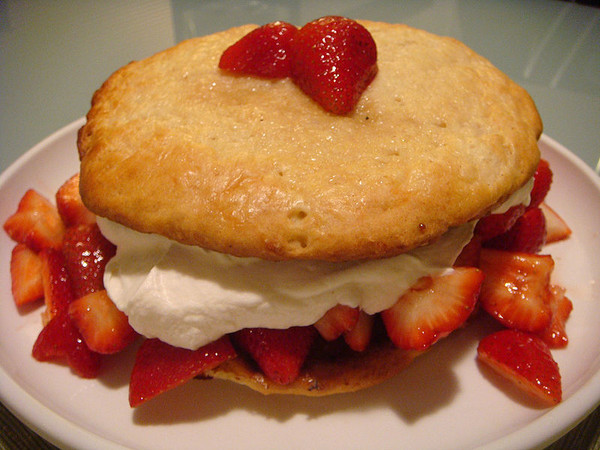Fruit Short-Cake
By Barbara Schock
The article provided homemakers with several
options for preparing the biscuit dough at home.
Some recipes were made with milk or buttermilk and
others with clabbered milk or sour cream. The
dough was patted or rolled into rounds. These were
layered in a round baking pan. After the layers
were baked, they were split apart. The biscuit was
buttered and spread with mashed sweetened berries.
An application of whipped cream, meringue or
custard on top was the finishing touch.
As the summer season progressed, homemakers could
use the same biscuit recipe for raspberries,
huckleberries, blackberries or peaches.
In ancient times, the Romans enjoyed eating
strawberries which grew in the mountains. The
Colonists who came to these shores ate
strawberries. It was said that strawberries were
so prolific that one could hardly walk without
stepping on them. Of course, the fruit was much
smaller than the berries we enjoy today, but the
flavor was more intense.
The first record of a recipe for Strawberry Cake
in this country appeared in Miss Leslie’s Lady’s
Receipt Book published in 1847. The cake layers
were made like pie crust rather than biscuit.
Cultivation of strawberries began on the east
coast and spread to the southern states. A few
years later, the railroads began using ice in
railcars to carry fruit to the north. The demand
for strawberries just kept increasing. In the
Midwest strawberries were grown in many home
gardens. During the 19th century, numerous
varieties were produced for home gardening and
commercial production.
Since the end of World War II, most strawberries
are grown in California. The state universities
developed new varieties suited to the growing
conditions there. Special treatment of the soil
has increased the size of today’s strawberries to
gigantic proportions.
Strawberry socials at community churches or school
have been popular for more than a hundred years.
Platters of warm, rich biscuits spread with butter
and mashed strawberries in between layers and
whole berries on top attract young and old alike.
Strawberry shortcake has become a food which adds
appeal to a meal. The dessert creates a festive
dish for family celebrations and gatherings.
Clara Sandburg may not have been able to afford
strawberries for her family in the summer. August
Sandburg cultivated a garden with several types of
root vegetables which were deemed to be more
practical. They could be stored for winter
consumption. Perhaps there was a raspberry or
blackberry bush or two to provide some summertime
fruit. Let’s hope there was a strawberry social at
the Mission on South Seminary Street at which they
could enjoy the summer’s best dessert.
|
|
|
| Date | Title |
| June 10, 2013 | Fruit Short-Cake |
| June 3, 2013 | Horatio Alger, Author |
| May 27, 2013 | Memorial Day, 1887 |
| May 20, 2013 | Professor Jon W. Grubb |
| May 13, 2013 | Beginnings of Lombard University |
| May 6, 2013 | Young Sandburg’s View of Lombard College |
| April 29, 2013 | Thinking |
| April 22, 2013 | Robert Colville, Master Mechanic |
| April 15, 2013 | The Galesburg Opera House |
| April 8, 2013 | Grocery Stores and Sample Rooms |
| April 1, 2013 | A Hearty Breakfast |
| March 25, 2013 | The Lost Wallpaper Legend |
| March 18, 2013 | Martin G. Sandburg |
| March 4, 2013 | The Edison Talking Machine |
| February 25, 2013 | Joe Elser, Civil War Veteran |
| February 18, 2013 | Remember the Maine... |
| February 11, 2013 | Lincoln's Birthday |
| February 4, 2013 | Curiosity |
